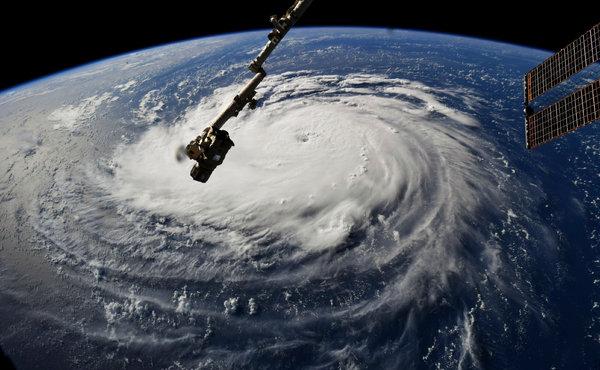Hurricane Florence has made landfall on the US East Coast, bringing with it winds, heavy rains and potentially “catastrophic” floods.
The centre of the storm struck Wrightsville Beach in North Carolina, with gales of up to 90mph (150 km/h).
Rains and surging seas have already inundated coastal areas. Scores of people are currently waiting to be rescued in the city of New Bern.
Evacuation warnings are in place for more than a million people.
Nearly half a million power outages have been reported across North Carolina, according to the state’s emergency management agency
The governor of North Carolina said surviving the storm would be a test of “endurance, teamwork, common sense, and patience”.
“This is an uninvited brute that just won’t leave,” Roy Cooper told NBC on Friday.
National Weather Service forecaster Brandon Locklear said North Carolina is likely to see eight months of rain in two to three days.
Conditions deteriorated throughout Thursday as the storm crawled along at 6mph (9.5km/ h). Some areas of North Carolina saw almost a foot of rain just a few hours, and footage showed sea levels begin to surge in land.
At 23:00 local time (03:00 GMT) the National Hurricane Centre (NHC) said wind speeds had slightly lowered, making it a category one hurricane.
The NHC says that despite the gradual lowering in wind strength, the storm remains extremely dangerous because of the high volume of rainfall and storm surges predicted.
“Inland flooding kills a lot of people, unfortunately, and that’s what we’re about to see,” said Brock Long, head of the Federal Emergency Management Agency (Fema).
He said that people living near rivers, streams and lowland areas in the region were most at risk.
The storm is forecast to dump about 18 trillion gallons of rainwater on US soil, most of it in North Carolina, meteorologist Ryan Maue tweeted.
In 2017 Hurricane Harvey dumped some 33 trillion gallons of rainwater in the US.
More than a million people have been ordered to leave the coasts of the Carolinas and Virginia, with more than 20,000 taking refuge in emergency shelters.
Asked what she was most worried about, Monica Scott, a young mother who had brought her children to a shelter in North Carolina, said: “Not having a place to go home to, or a job.”
This couple in South Carolina moved their wedding forward as the hurricane threatened
Not everyone, though, has obeyed the warnings.
Queues were reported outside a branch of Waffle House in the port city of Wilmington, North Carolina. The restaurant is used as a measure of how bad storms are.
A man in North Carolina said he would stay with his dog, since shelters were not taking pets. “I’m not leaving him here,” Antonio Ramirez told the AFP news agency,
More than 455,775 homes and businesses are already without power, but energy companies warn up to three million homes and businesses could lose electricity.
Officials have warned restoring electricity could take days or even weeks. Petrol stations in the area are also reporting shortages.
Parts of New Bern, North Carolina, are 3m (10 feet) underwater and 150 people are waiting to be rescued, authorities there said.
Davice Daniels from the New Bern Police Department said those unable to leave their homes should move up to higher floors.
But officials warn against entering attics, unless people have a means to cut through to the roof to avoid drowning.
In Jacksonville, North Carolina, officials rescued about 60 people overnight from a hotel that was collapsing in the storm.
Emergency workers arrived to find the Triangle Motor Inn’s structure crumbling, with many guests still in their rooms.
As parts of the roof caved in, police had to force their way into some rooms amid 75mph winds to reach those inside.
All of the occupants, who included children and pets, were safely rescued.
Over 1,100 flights have been cancelled, according to FlightAware.com, as most of the coastal region’s airports are closed to ride out the storm.
At the White House, President Donald Trump has been retweeting local emergency officials’ updates and tips for surviving the storm.
Latest predictions show the storm slowing to a near standstill as it pummels the coast with “copious amounts of rain” from Thursday night to Saturday.
Wind speeds are only expected to weaken on Saturday as the storm moves slowly across land.
More than a dozen counties in North Carolina are under a tornado watch, with officials also warning of a chance of hail.
CREDIT:BBC




